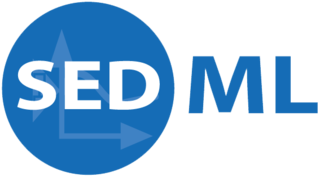Related Research Articles

In computer text processing, a markup language is a system for annotating a document in a way that is syntactically distinguishable from the text. The idea and terminology evolved from the "marking up" of paper manuscripts, which is traditionally written with a red or blue pencil on authors' manuscripts. In digital media, this "blue pencil instruction text" was replaced by tags, which indicate what the parts of the document are, rather than details of how they might be shown on some display. This lets authors avoid formatting every instance of the same kind of thing redundantly. It also avoids the specification of fonts and dimensions which may not apply to many users.

Extensible Markup Language (XML) is a markup language that defines a set of rules for encoding documents in a format that is both human-readable and machine-readable. The W3C's XML 1.0 Specification and several other related specifications—all of them free open standards—define XML.
Computational biology involves the development and application of data-analytical and theoretical methods, mathematical modeling and computational simulation techniques to the study of biological, ecological, behavioral, and social systems. The field is broadly defined and includes foundations in biology, applied mathematics, statistics, biochemistry, chemistry, biophysics, molecular biology, genetics, genomics, computer science and evolution.

Biological databases are libraries of life sciences information, collected from scientific experiments, published literature, high-throughput experiment technology, and computational analysis. They contain information from research areas including genomics, proteomics, metabolomics, microarray gene expression, and phylogenetics. Information contained in biological databases includes gene function, structure, localization, clinical effects of mutations as well as similarities of biological sequences and structures.
Cheminformatics is the use of computer and informational techniques applied to a range of problems in the field of chemistry. These in silico techniques are used, for example, in pharmaceutical companies and academic settings in the process of drug discovery. These methods can also be used in chemical and allied industries in various other forms.
The Gene Ontology (GO) is a major bioinformatics initiative to unify the representation of gene and gene product attributes across all species. More specifically, the project aims to: 1) maintain and develop its controlled vocabulary of gene and gene product attributes; 2) annotate genes and gene products, and assimilate and disseminate annotation data; and 3) provide tools for easy access to all aspects of the data provided by the project, and to enable functional interpretation of experimental data using the GO, for example via enrichment analysis. GO is part of a larger classification effort, the Open Biomedical Ontologies (OBO).
The following tables compare general and technical information for a number of document-markup languages. Please see the individual markup languages' articles for further information.
XGMML is an XML application based on GML which is used for graph description. Technically, while GML is not related to XML nor SGML, XGMML is an XML application that is so designed that there's a 1:1 relation towards GML for trivial conversion between the two formats.

The Systems Biology Ontology (SBO) is a set of controlled, relational vocabularies of terms commonly used in Systems Biology, and in particular in computational modeling. SBO is part of the BioModels.net effort.
Data exchange is the process of taking data structured under a source schema and transforming it into data structured under a target schema, so that the target data is an accurate representation of the source data. Data exchange allows data to be shared between different computer programs.
Physiomics is a systematic study of physiome in biology. Physiomics employs bioinformatics to construct networks of physiological features that are associated with genes, proteins and their networks. A few of the methods for determining individual relationships between the DNA sequence and physiological function include metabolic pathway engineering and RNAi analysis. The relationships derived from methods such as these are organized and processed computationally to form distinct networks. Computer models use these experimentally determined networks to develop further predictions of gene function.
BioPAX is a RDF/OWL-based standard language to represent biological pathways at the molecular and cellular level. Its major use is to facilitate the exchange of pathway data. Pathway data captures our understanding of biological processes, but its rapid growth necessitates development of databases and computational tools to aid interpretation. However, the current fragmentation of pathway information across many databases with incompatible formats presents barriers to its effective use. BioPAX solves this problem by making pathway data substantially easier to collect, index, interpret and share. BioPAX can represent metabolic and signaling pathways, molecular and genetic interactions and gene regulation networks. BioPAX was created through a community process. Through BioPAX, millions of interactions organized into thousands of pathways across many organisms, from a growing number of sources, are available. Thus, large amounts of pathway data are available in a computable form to support visualization, analysis and biological discovery.
Biology data visualization is a branch of bioinformatics concerned with the application of computer graphics, scientific visualization, and information visualization to different areas of the life sciences. This includes visualization of sequences, genomes, alignments, phylogenies, macromolecular structures, systems biology, microscopy, and magnetic resonance imaging data. Software tools used for visualizing biological data range from simple, standalone programs to complex, integrated systems.
COPASI is an open-source software application for creating and solving mathematical models of biological processes such as metabolic networks, cell-signaling pathways, regulatory networks, infectious diseases, and many others.

LibSBML is an open-source software library that provides an application programming interface (API) for the SBML format. The libSBML library can be embedded in a software application or used in a web servlet as part of the application or servlet's implementation of support for reading, writing, and manipulating SBML documents and data streams. The core of libSBML is written in ISO standard C++; the library provides API for many programming languages via interfaces generated with the help of SWIG.

The Simulation Experiment Description Markup Language (SED-ML) is a representation format, based on XML, for the encoding and exchange of simulation descriptions on computational models of biological systems. It is a free and open community development project.
References
- ↑ Kyoda, Koji; Tohsato, Yukako; Ho, Kenneth H. L.; Onami, Shuichi (2015). "Biological Dynamics Markup Language (BDML): An open format for representing quantitative biological dynamics data". Bioinformatics. 31 (7): 1044–1052. doi:10.1093/bioinformatics/btu767. PMC 4382901 . PMID 25414366.